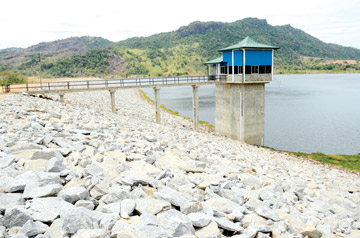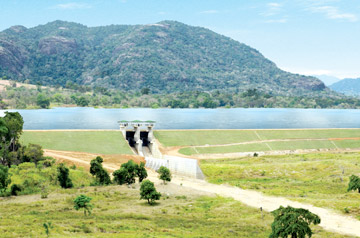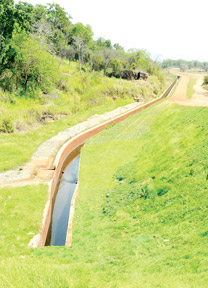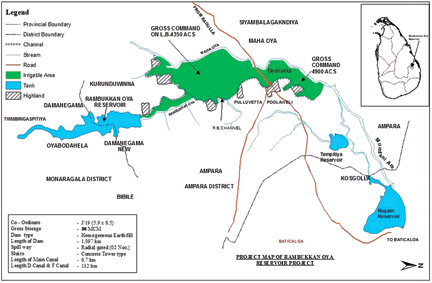Rambukkan Oya Irrigation project ready from July 20
By P. Krishnaswamy
The Rs.3,970 million, multipurpose Rambukkan Oya Irrigation and Water
Supply Project, one more among the major agricultural and rural
development projects under the Mahinda Chintana concept has been
completed and President Mahinda Rajapaksa will ceremonially declare it
open next Saturday, July 20. The President will also hand over legal
deeds of alternative lands to 72 families whose lands were inundated,
Director General (DG)of the Irrigation Department Ms.Bhadra Kamaladasa
said.
 |
| Rambukkan Oya
sluice tower |
 |
| Rambukkan Oya
reservoir |
|

Rambukkan Oya canal |
Five minor tanks which were rehabilitated under the project and two
newly constructed tanks will be fed by the 6.7 km irrigation canal of
the project, the DG said. It is admirable that the local population
withstood terrorist threats for 30 long years without any security and
continued to stay in their traditional habitats eking out a meagre
living. The project has come as a blessing to them, she said. About
2,300 acres of paddy lands and 1,200 acres of highlands will be brought
under cultivation under the project. The living standards of the
poverty-stricken local families have already shown marked improvement,
she said.
The changing landscape of the area, the gradual transformation from
arid impoverished land to a land of lush vegetation can also be seen,
she said. Rambukkan Oya is one of the three tributaries of the Mundeni
Aru River and when plans to develop areas of the other two tributaries (Galodai
Oya and Maha Oya) come into force in the near future, the local
communities of many regions of the Eastern province will be similarly
benefited, Kamaladasa said.
The Mundeni Aru basin in which the Rambukkan Oya reservoir is located
is numbered as river basin No. 52 and located in the Amapara and
Batticaloa districts. The Mundeni Aru flows between Maduru Oya and Gal
Oya. This is a rural undeveloped basin with a catchment area of 1,280 km
2. The effects of the flood situation frequently experienced in the
province will also be considerably reduced under the present project and
the other reservoir projects in the pipeline, Kamaladsa said.
Other details of the project were also elaborated by senior officials
of the Department.
Exclusively designed and constructed by the Sri Lankan engineers of
the Irrigation Department and started in May 1977 the project will
benefit the local population... Major benefits are irrigation facilities
to 4000 acres of arable lands , allotment of the lands among the 2,100
landless peasants of the area and drinking water facilities to the local
communities of the region numbering over 50,000 families through
replenishment of ground water aquifers.
The overall benefits encompass economic benefits and health benefits;
enhancement of nutritional levels of the community; and social welfare
facilities. More than 2,300 agricultural families are directly benefited
under this project. The project is mainly aimed at improving the
livelihood and economic conditions of the local community and all
incentives will be extended to them by the Government, including for
vegetable and fruit cultivation and animal husbandry, aside from
assistance for paddy cultivation. The project area is one of the worst
underdeveloped areas in the country with hardly any facilities or public
utilities compared with the rest of the country. Then area is sparsely
populated and population density is less than 43 persons per sq. km.
About 85 percent of the land belong to the State, about 05 percent is
owned by private parties and 10 percent of the lands are occupied by
unauthorised settlers. In the Maha Oya Divisional Secretary Division, 64
percent of the people are unemployed, 24 percent partially employed and
only 12 percent are fully employed. About 76 percent of the employed are
engaged in agriculture while about 10 percent are engaged in the private
sector and commercial enterprises.
|

Rambukkan Oya project |
The necessity of development programs for the benefit of the
population of the Dry Zone in Sri Lanka arose due to many reasons but
mainly owing to the food security of the people. The lack of food
security arose due to disruption of agrarian systems, land
fragmentation, lack of irrigable land, indebtedness of the farmers and
poor post-harvest technology.
The backbone of the population of the dry zone is based on
agriculture with almost 85 percent of them depending on it for their
livelihood. Nearly two-thirds of the land area of the country comes
under the dry zone.
The contribution that agriculture makes to household income has been
declining and poverty and unemployment have been on the rise.
But there has been a marked progress in the production of rice and
other crops under the Mahaveli Development programs.
It has also contributed to rural development and health care services
to the poor and the needy. Several programs for the development and
improvement of water resources in the dry zone to ensure efficient and
maximum utilisation of the vastly available land resources in the dry
zone areas are now under implementation. Many historical remnants depict
that King Saddathissa had started to construct a reservoir in 400 AD.
The one mile long ancient bund can be seen even today at
Watawanakandiya. But due to unknown reasons the construction of the
reservoir had not been completed.
The Rambukkan Oya Project area was declared as a Resident Project
Manager's area under the MASL on 18.08.2010 by granting the mandate to
plan and implement integrated development activities on land
development, agriculture, community development, environmental
conservation and post settlement activities.
This planned reservoir by the Irrigation Department brings benefits
to both the Ampara and Batticaloa districts by providing the much needed
water for the development of 200 ha. of the arid lands in addition to
providing drinking water and other infrastructure development.
About 859 MCM of untapped water of the Mundeni Aru falls in the sea
which has a catchment area of 1280sq/km.
The Rambukkan Oya reservoir will provide facilities to store 56MCM of
this untapped water. The District Secretariat divisions coming under the
Rambukkan Oya project are Maha Oya and Padiyatalawa with 17 and 20 Grama
Niladhari divisions in them respectively. The total population as in
2008 was 41,559 with the Maha Oya having a land area of 667 sq.km and
Padiyatalawa having 379 sq. km.
The main towns are Maha Oya and Padiyatalawa and the main highways
are Mahiyangana-Ampara highway and the Mahiyangana-Batticaloa highway.
In addition to the severe shortage of water for the cultivation of
paddy, a similar situation is encountered even during the Yala season
and, therefore, it became necessary to develop water resources in the
basin in an integrated manner to meet the water demands of different
sectors.
The farmstead land area under the Rambukkan Oya project is 3500 acres
(1400 ha) and the land for other food crops is 2000 acres (800 ha).
The homestead lots are 4000 (05 acres/0.2 ha) and proposed irrigable
lots are 23333 (1.5 acres/0.6 ha. Common facilities are 01 (one) Area
Center and 03 (three) Village Centers.
Other infrastructure facilities to the people of the Maha Oya
Divisional Secretary division include road networks, electricity,
schools and clean drinking water which will largely contribute to the
improvement of the quality of the life of people.
The length of the main canal of the project is 6.7 km, the length of
the distributory canal is 40 km and the length of the field canals is 92
km. |


